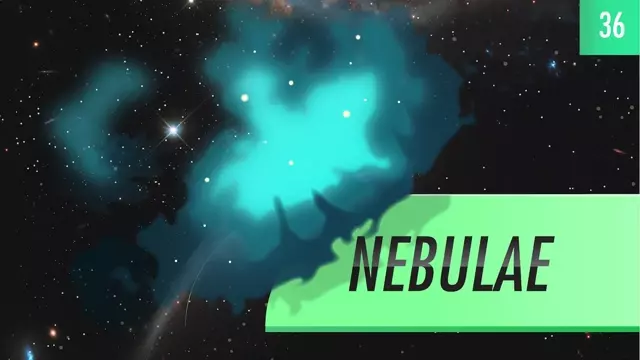2015-10-15
[public] 928K views, 16.8K likes, 178 dislikes audio only
Astronomers study a lot of gorgeous things, but nebulae might be the most breathtakingly beautiful of them all. Nebulae are clouds of gas and dust in space. They can glow on their own or reflect light from nearby stars. When they glow it’s usually predominantly red from hydrogen and green from oxygen, and when they reflect and scatter light it’s from massive hot stars, so they look blue. Stars are born in some nebulae and create new ones as they die. Some nebulae are small and dense, others can be dozens or hundreds of lightyears across.
Check out the Crash Course Astronomy solar system poster here: http://store.dftba.com/products/crashcourse-astronomy-poster
--
Chapters:
Introduction: Nebulae 00:00
Emission Nebulae 1:17
Reflection Nebulae 2:36
Molecular Clouds 3:43
The Orion Nebula 5:07
Stars Form in Nebulae 6:42
Edges of Nebulae 8:32
Viewing Nebulae in the Infrared 10:10
Review 11:04
--
PBS Digital Studios: http://youtube.com/pbsdigitalstudios
Follow Phil on Twitter: https://twitter.com/badastronomer
Want to find Crash Course elsewhere on the internet?
Facebook - http://www.facebook.com/YouTubeCrashCourse
Twitter - http://www.twitter.com/TheCrashCourse
Tumblr - http://thecrashcourse.tumblr.com
Support CrashCourse on Patreon: http://www.patreon.com/crashcourse
--
PHOTOS/VIDEOS
Saturn https://www.flickr.com/photos/badastronomy/10328043663/sizes/o/in/photostream/ [credit: Photo by NASA / JPL / Space Science Institute / Gordan Ugarkovic]
Carina Nebula http://www.spacetelescope.org/news/heic0707/ [credit: NASA, ESA, N. Smith (University of California, Berkeley), and The Hubble Heritage Team (STScI/AURA)]
Crab Nebula http://sci.esa.int/herschel/53338-herschel-and-hubble-composite-image-of-the-crab-nebula/ [credit: ESA/Herschel/PACS/MESS Key Programme Supernova Remnant Team; NASA, ESA and Allison Loll/Jeff Hester (Arizona State University)]
Carina Jets http://www.spacetelescope.org/images/heic1007a/ [credit: NASA, ESA, M. Livio and the Hubble 20th Anniversary Team (STScI)]
The Twin Jet Nebula http://www.spacetelescope.org/images/heic1518a/ [credit: ESA/Hubble & NASA]
Tycho's Supernova Remnant http://chandra.harvard.edu/photo/2011/tycho/ [credit: X-ray: NASA/CXC/Rutgers/K.Eriksen et al.; Optical: DSS]
Ring Nebula's True Shape http://hubblesite.org/newscenter/archive/releases/2013/13/image/a/ [credit: NASA, ESA, C.R. O'Dell (Vanderbilt University), and D. Thompson (Large Binocular Telescope Observatory)]
3D animation of the Orion nebula http://www.spacetelescope.org/videos/astro_bo/ [credit: ESO/M. Kornmesser]
Stardust http://stardust.jpl.nasa.gov/images/science/idp-m.jpg [credit: NASA]
From the Pleiades to the Hyades http://www.deepskycolors.com/archive/2011/11/06/from-the-Pleiades-to-the-Hyades.html [credit: Rogelio Bernal Andreo]
How to Become a Star http://www.eso.org/public/images/eso0102a/ [credit: ESO]
The Orion Nebula http://www.eso.org/public/images/eso1103a/ [credit: ESO/Igor Chekalin]
Trapezium Cluster in the Orion Nebula http://www.spacetelescope.org/images/opo0019b/ [credit: K.L. Luhman (Harvard-Smithsonian Center for Astrophysics, Cambridge, Mass.); and G. Schneider, E. Young, G. Rieke, A. Cotera, H. Chen, M. Rieke, R. Thompson (Steward Observatory, University of Arizona, Tucson, Ariz.) and NASA/ESA]
PIA08656 http://www.jpl.nasa.gov/spaceimages/images/largesize/PIA08656_hires.jpg [credit: NASA/JPL-Caltech/IRAS/H. McCallon]
Edge-On Protoplanetary Disc in the Orion Nebula http://www.spacetelescope.org/images/opo9545h/ [credit: Mark McCaughrean (Max-Planck-Institute for Astronomy), C. Robert O'Dell (Rice University), and NASA/ESA]
Hubble's sharpest image of the Orion Nebula with proplyd highlights https://www.spacetelescope.org/images/heic0917ab/ [credit: NASA, ESA, M. Robberto (Space Telescope Science Institute/ESA), the Hubble Space Telescope Orion Treasury Project Team and L. Ricci (ESO)]
Young Stellar Disks in Infrared http://www.spacetelescope.org/images/opo9905b/ [credit: D. Padgett (IPAC/Caltech), W. Brandner (IPAC), K. Stapelfeldt (JPL) and NASA/ESA]
The Eagle Nebula, M16 https://www.noao.edu/image_gallery/html/im0725.html [credit: T.A.Rector (NRAO/AUI/NSF and NOAO/AURA/NSF) and B.A.Wolpa (NOAO/AURA/NSF)]
Pillars of Creation http://hubblesite.org/newscenter/archive/releases/2015/01/image/e/warn/ [credit: NASA, ESA, and the Hubble Heritage Team (STScI/AURA)]
Planetary Nebula HFG1 https://www.noao.edu/image_gallery/html/im1110.html [credit: T.A. Rector (University of Alaska Anchorage) and H. Schweiker (WIYN and NOAO/AURA/NSF)]
Zooming in on the Horsehead Nebula http://www.spacetelescope.org/videos/heic1307c/ [credit: NASA, ESA, and G. Bacon (STScI); ESO]
Orion, from Head to Toes http://www.deepskycolors.com/archive/2010/10/22/orion-from-Head-to-Toes.html [credit: Rogelio Andreo Bernal]
Sifting through Dust near Orion’s Belt (mouseover comparison) http://www.eso.org/public/images/comparisons/eso1219a/ [credit: ESO/APEX (MPIfR/ESO/OSO)/T. Stanke et al./Igor Chekalin/Digitized Sky Survey 2]
/youtube/video/W8UI7F43_Yk?t=0
/youtube/video/W8UI7F43_Yk?t=77
/youtube/video/W8UI7F43_Yk?t=156
/youtube/video/W8UI7F43_Yk?t=223
/youtube/video/W8UI7F43_Yk?t=307
/youtube/video/W8UI7F43_Yk?t=402
/youtube/video/W8UI7F43_Yk?t=512
/youtube/video/W8UI7F43_Yk?t=610

